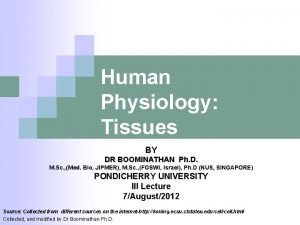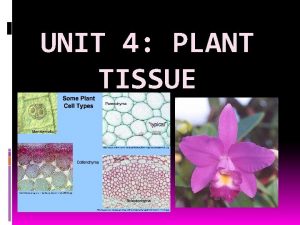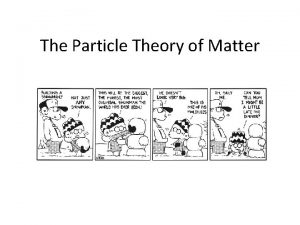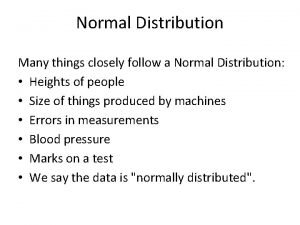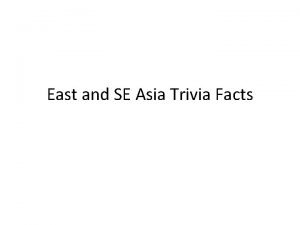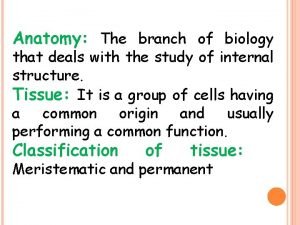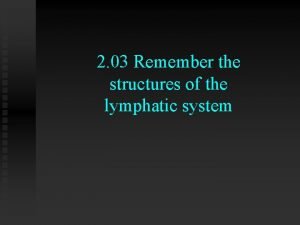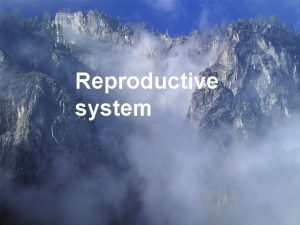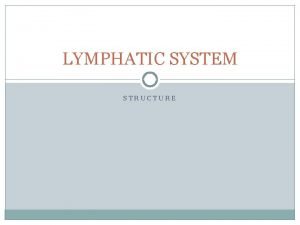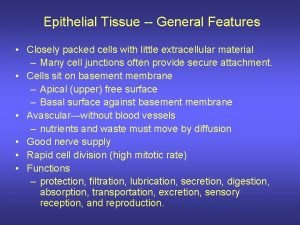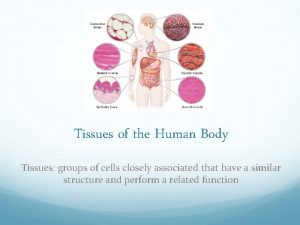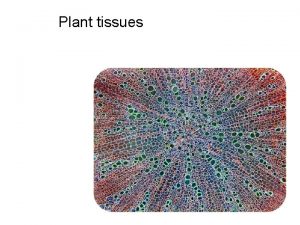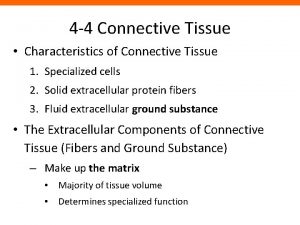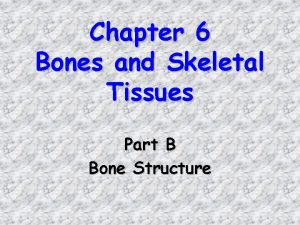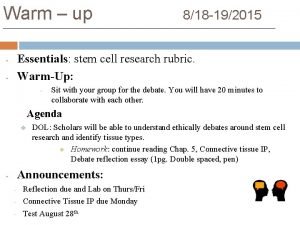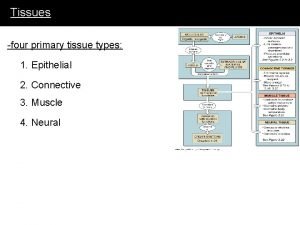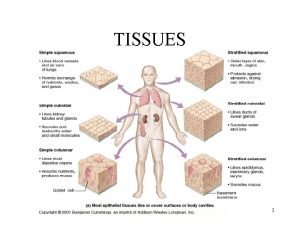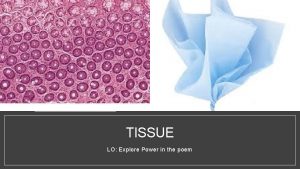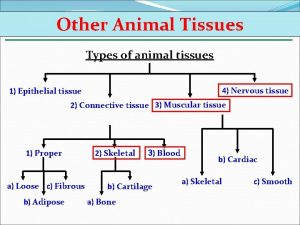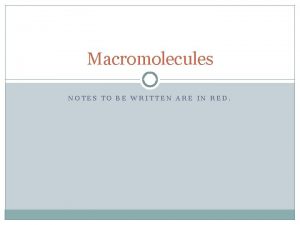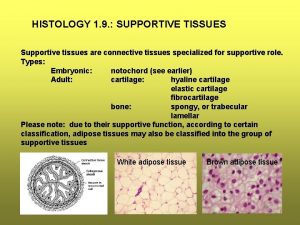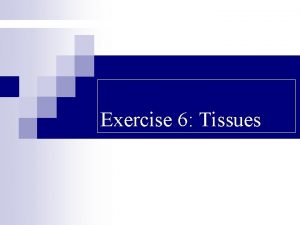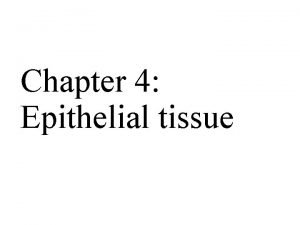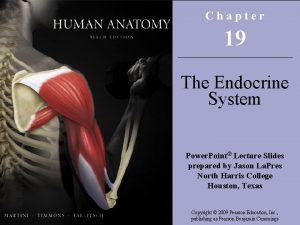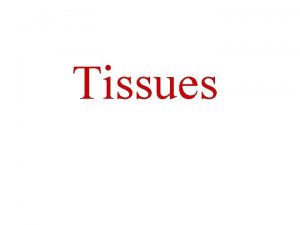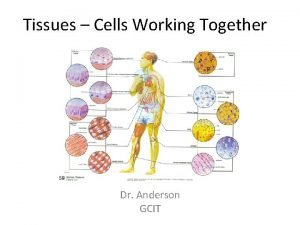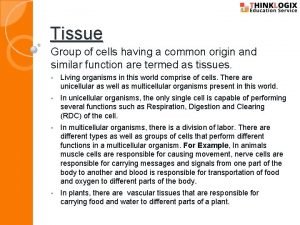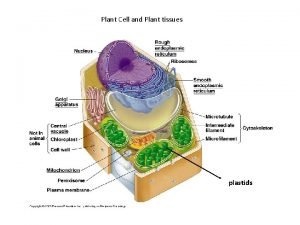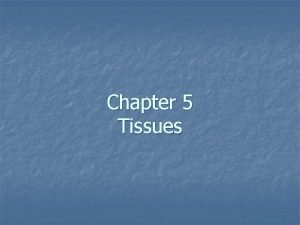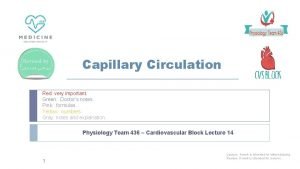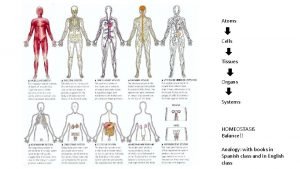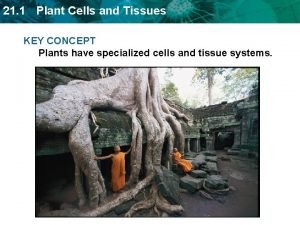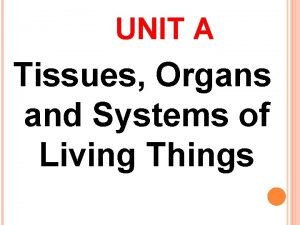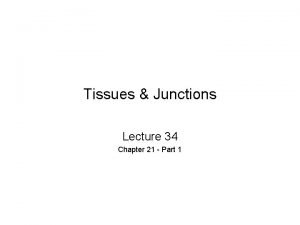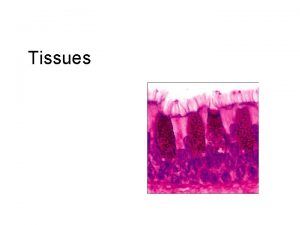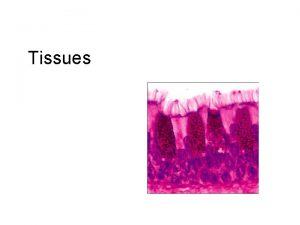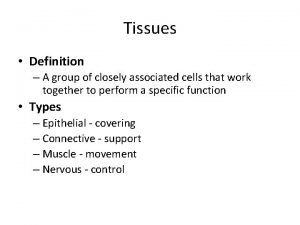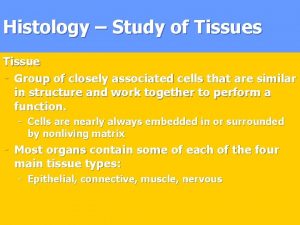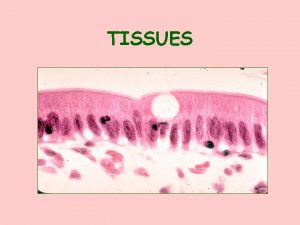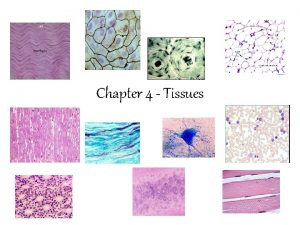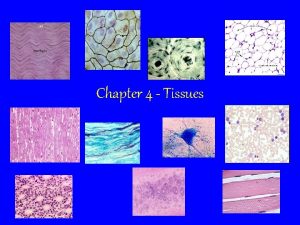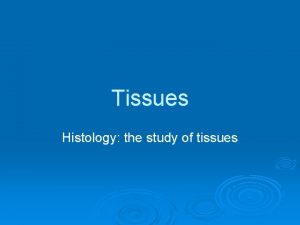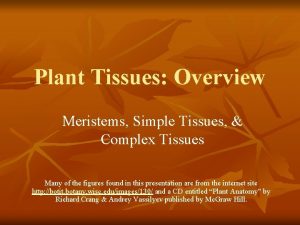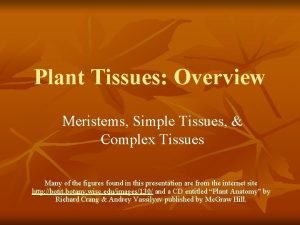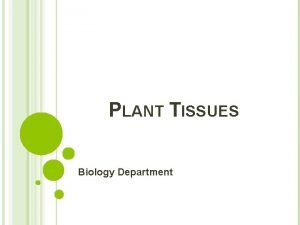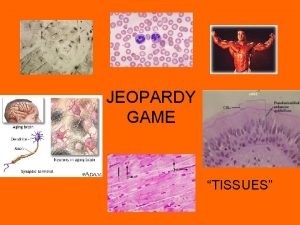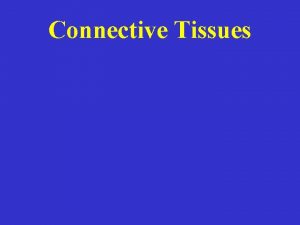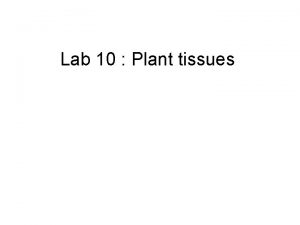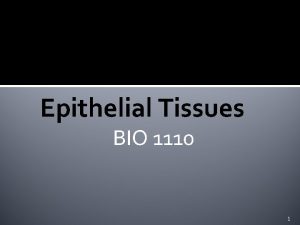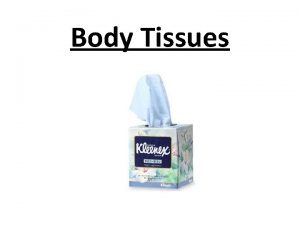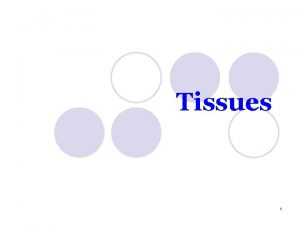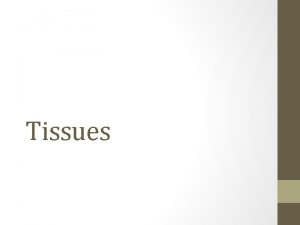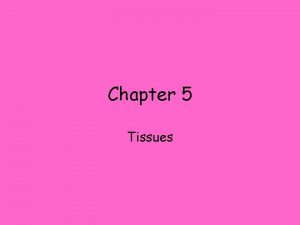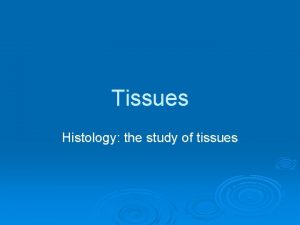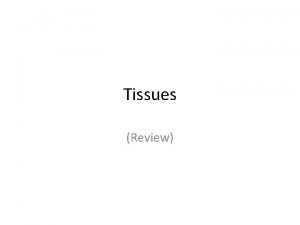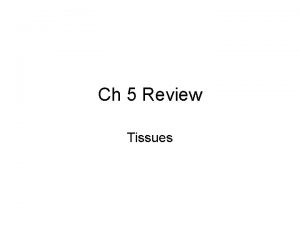Tissues Tissues Definition a group of closely associated






































































- Slides: 70

Tissues

Tissues Definition: a group of closely associated cells that perform related functions and are similar in structure n Between cells: nonliving extracellular material n Four basic types of tissue…function n ¨ Epithelium…covering ¨ Connective tissue…support ¨ Muscle tissue…movement ¨ Nervous tissue…control

Cell Junctions n Tight Junctions: Contain web like strands of transmembrane proteins that fuse outer layers of adjacent plasma membranes together. These retard passage of liquids between cells. They prevent leakage and keep certain tissues more or less water tight. Would you expect to see these in tissue of the urinary bladder? Why?

Cell Junctions n Adherences Junctions: Contain plaque, which is a dense layer of proteins inside of the plasma membrane which attaches to the cytoskeleton and to the plasma membrane proteins. Adherences junctions help epithelial surfaces resist separation.

Cell Junctions n Desmosomes also contain plaque. They serve such purposes as keeping cardiac muscle fibers from separating during contraction and keeping epithelial cells from separating under tension.

Cell Junctions Hemidesmisomes anchor cells to basement membranes (we’ll talk more about this later). n They look like “half desmisomes” but are structured differently (chemically). n

Cell Junctions Gap Junctions: contain proteins called connexins that produce tiny fluid filled tunnels called connexons. These allow the cells in tissues to communicate with one another. n In embryos, these may allow exchange of electrical and chemical info important in differentiation. n

Gap junctions (continued) These also enable nerve and muscle impulses to spread rapidly among cells n This is a process that is important for normal operation of some parts of the nervous system, for the contraction of the heart muscle and the muscles in the gastrointestinal (GI) tract. n

Cell Junctions n Tight junctions ¨ n Adherens junctions ¨ n So close that are sometimes impermeable Transmembrane linker proteins Desmosomes Anchoring junctions ¨ Filaments anchor to the opposite side ¨ n Gap junctions ¨ Allow small molecules to move between cells



Germ Layers All tissues of body develop from 3 primary germ layers that form in a human embryo. n Mesoderm gives rise to all connective tissues and most muscle tissues as well as some epithelial tissue n Ectoderm gives rise to nerve tissue and epithelial tissue. n Endoderm gives rise to epithelial tissue. n


Epithelia (plural) n n n Epithelium: sheet of cells that covers a body surface or lines a body cavity; also form most of the body’s glands Roles: as interfaces and as boundaries Functions: Protection Absorption Sensory reception Ion transport Secretion Filtration Formation of slippery surfaces for movement

Special characteristics of epithelia n n n Cellularity Specialized contacts Polarity ¨ Free upper (apical) surface ¨ Lower (basal) surface contributing basal lamina to basement membrane n n Support by connective tissue Avascular but innervated ¨ Without vessels ¨ With nerve endings n Regeneration

Classification of epithelia n According to thickness ¨ “simple” - one cell layer ¨ “stratified” – more than one layer of cells (which are named according to the shape of the cells in the apical layer) n According to shape ¨ “squamous” – wider than tall ¨ “cuboidal” – as tall as wide ¨ “columnar” - taller than wide

to protect

where diffusion is important where tissues are involved in secretion and absorption: larger cells because of the machinery of production, packaging, and energy requirements



“ciliated” literally = eyelashes (see next page)


Stratified: regenerate from below

Rare…

Rare…


Endothelium A simple squamous epithelium that lines the interior of the circulatory vessels and heart Mesothelium Simple squamous epithelium that lines the peritoneal, pleural and pericardial cavities and covers the viscera

Glands Epithelial cells form them n Production & secretion of needed substances n Are aqueous (water-based) products n The protein product is made in rough ER, packed into secretory granules by Golgi apparatus, released from the cell by exocytosis n

Classification of glands n By where they release their product ¨ Exocrine: external secretion onto body surfaces (skin) or into body cavities ¨ Endocrine: secrete messenger molecules (hormones) which are carried by blood to target organs; “ductless” glands n By whether they are unicellular or multicellular

Exocrine glands unicellular or multicellular Unicellular: goblet cell scattered within epithelial lining of intestines and respiratory tubes Product: mucin mucus is mucin & water

Multicellular exocrine glands Epithelium-walled duct and a secretory unit

Examples of exocrine gland products Many types of mucus secreting glands n Sweat glands of skin n Oil glands of skin n Salivary glands of mouth n Liver (bile) n Pancreas (digestive enzymes) n Mammary glands (milk) n

Endocrine glands n Ductless glands n Release hormones into extracellular space ¨ Hormones n are messenger molecules Hormones enter blood and travel to specific target organs

Epithelial surface features n Lateral surface ¨ Adhesion proteins ¨ Tongue and groove wavy contours ¨ Cell junctions: see next slide n Basal surface ¨ Basal lamina: noncellular sheet of protein together with reticular fibers form basement membrane n Apical surface

Apical surface features n Microvilli – maximize surface area ¨ Fingerlike extensions of the plasma membrane of apical epithelial cells ¨ On moist and mucus secreting epithelium ¨ Longest on epithelia that absorb nutrients (small intestine) or transport ions (kidneys) (continued)

n Cilia ¨ Whiplike motile extentions of the apical surface membranes n Flagellum ¨ Long isolated cilium ¨ Only found as sperm in human


n Four basic types of tissue ¨Epithelium ¨Connective tissue n Connective tissue proper (examples: fat tissue, fibrous tissue of ligaments) n Cartilage n Bone n Blood ¨Muscle tissue ¨Nervous tissue

Classes of Connective Tissue: note the cell types and great variety of subclasses

Connective Tissue n n Originate from embryonic tissue called mesenchyme Most diverse and abundant type of tissue Many subclasses (see previous slide) Function: to protect, support and bind together other tissues ¨ Bones, ligaments, tendons ¨ Areolar cushions; adipose insulates and is food source ¨ Blood cells replenished; body tissues repaired n Cells separated from one another by large amount of nonliving extracellular matrix

Extracellular Matrix explained n n Nonliving material between cells Produced by the cells and then extruded Responsible for the strength Two components 1. Ground substance ¨ ¨ 2. Of fluid, adhesion proteins, proteoglycans Liquid, semisolid, gel-like or very hard Fibers: collagen, elastic or reticular

Basic functions of connective tissue reviewed Support and binding of other tissues n Holding body fluids n Defending the body against infection n ¨ macrophages, n plasma cells, mast cells, WBCs Storing nutrients as fat

Classes of Connective Tissue *





Classes of Connective Tissue *



Classes of Connective Tissue *




Classes of Connective Tissue *


Classes of Connective Tissue *


Membranes that combine epithelial sheets plus underlying connective tissue proper (see next slide) n Cutaneous membranes ¨ Skin: n epidermis and dermis Mucous membranes, or mucosa ¨ Lines every hollow internal organ that opens to the outside of the body n Serous membranes, or serosa ¨ Slippery membranes lining the pleural, pericardial and peritoneal cavities ¨ The fluid formed on the surfaces is called a transudate n Synovial membranes ¨ Line joints

(a) Cutaneous membrane (b) Mucous membrane (c) Serous membrane

n Four basic types of tissue ¨Epithelium ¨Connective tissue ¨Muscle tissue n Skeletal n Cardiac n Smooth ¨Nervous tissue




n Four basic types of tissue ¨Epithelium ¨Connective tissue ¨Muscle tissue ¨Nervous tissue n Neurons n Supporting cells


Tissue response to injury n n Immune: takes longer and is highly specific Inflammation ¨ Nonspecific, local, rapid ¨ Inflammatory chemicals ¨ Signs: heat, swelling, redness, pain n Repair – two ways ¨ Regeneration ¨ Fibrosis n n and scarring Severe injuries Cardiac and nervous tissue


Tumors (neoplasms): abnormal growth of cells Adenoma – neoplasm of glandular epithelium, benign or malignant n Carcinoma – cancer arising in an epithelium (90% of all human cancers) n Sarcoma – cancer arising in mesenchymederived tissue (connective tissues and muscle) n

STEM CELLS…. ______ Inner cell mass becomes the baby STEM CELLS
 The psychodynamic perspective is closely associated with
The psychodynamic perspective is closely associated with Cyclical unemployment is closely associated with
Cyclical unemployment is closely associated with Ivan pavlov is most closely associated with
Ivan pavlov is most closely associated with Body tissue
Body tissue The four major categories of tissues are
The four major categories of tissues are Body tissues chapter 3 cells and tissues
Body tissues chapter 3 cells and tissues Cells form tissues. tissues form __________.
Cells form tissues. tissues form __________. Body tissues chapter 3 cells and tissues
Body tissues chapter 3 cells and tissues _______is a group of closely related species.
_______is a group of closely related species. Cell to tissue to organ to organ system to organism
Cell to tissue to organ to organ system to organism Reticular connective tissue function and location
Reticular connective tissue function and location Goblet cells cilia and microvilli
Goblet cells cilia and microvilli Closely packed elongated cells with corners thickened
Closely packed elongated cells with corners thickened Gas liquid
Gas liquid Stakeholder mapping exercise
Stakeholder mapping exercise What is threat matrix
What is threat matrix Many things closely follow a normal distribution
Many things closely follow a normal distribution What does this drawing indicate about the inca civilization
What does this drawing indicate about the inca civilization Xi river china map
Xi river china map Its molecules are closely packed together.
Its molecules are closely packed together. Closely held corporation def
Closely held corporation def At certain region the phellogen cuts off closely arranged
At certain region the phellogen cuts off closely arranged The lymphatic structure that closely parallel veins
The lymphatic structure that closely parallel veins Look at the pictures then discuss the questions
Look at the pictures then discuss the questions Spermatogonium
Spermatogonium If you look closely at some
If you look closely at some What lymphatic structures closely parallel veins
What lymphatic structures closely parallel veins Lymphatic structure that closely parallel veins
Lymphatic structure that closely parallel veins Filtration epithelial tissue
Filtration epithelial tissue Specialized connective tissue
Specialized connective tissue Collagen location in body
Collagen location in body Helianthus stem
Helianthus stem 3 tissues of a plant
3 tissues of a plant Akar dikotil
Akar dikotil Hannah campion
Hannah campion Mesophyll function
Mesophyll function Tissues causes of civil war
Tissues causes of civil war Adipose epithelial tissue
Adipose epithelial tissue Dense connective
Dense connective Tissues are groups of similar cells working together to
Tissues are groups of similar cells working together to Genetic effects on gene expression across human tissues
Genetic effects on gene expression across human tissues Chapter 6 bones and skeletal tissues
Chapter 6 bones and skeletal tissues Types of tissues
Types of tissues Four primary tissues
Four primary tissues Tissues are groups of similar cells working together to
Tissues are groups of similar cells working together to Tissue structure poem
Tissue structure poem Types of tissues
Types of tissues What macromolecule is a prominent part of animal tissues
What macromolecule is a prominent part of animal tissues Division of anatomy
Division of anatomy What are supportive tissues
What are supportive tissues What is this tissue
What is this tissue Identify the cell
Identify the cell Stratified squamous epithelium function
Stratified squamous epithelium function Which part of the cell contains genetic material
Which part of the cell contains genetic material Chapter 3 cells and tissues figure 3-7
Chapter 3 cells and tissues figure 3-7 Pearson endocrine system
Pearson endocrine system What are the four major tissue types
What are the four major tissue types Tissues working together
Tissues working together A tissue is a group of cells having
A tissue is a group of cells having Tissues in circulatory system
Tissues in circulatory system Basal lamina
Basal lamina Plastid
Plastid Periradicular
Periradicular What do all connective tissues have in common
What do all connective tissues have in common Four principal types of tissue
Four principal types of tissue What is the function of the golgi apparatus
What is the function of the golgi apparatus Arterial vs venous end of capillary
Arterial vs venous end of capillary Analogy of tissues
Analogy of tissues Cohesion bond
Cohesion bond Cell wall function
Cell wall function What is tissue?
What is tissue?











